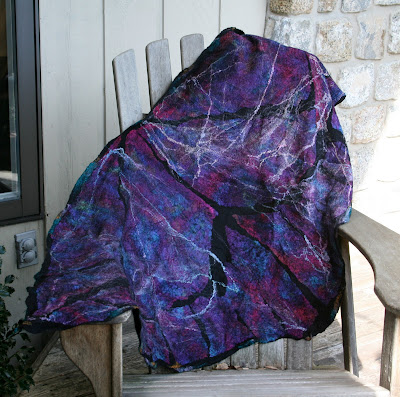Things I hadn't anticipated:
You need a really big table to make a butterly. The books say to assume your project will shrink by 50%. So you have to make it pretty big to start. A 10 foot table would have been perfect. I was using an 8 foot table, and two of the other students were using smaller tables. In retrospect, if I had had the smaller tables, I probably would have cried partway through. The students with the smaller tables had to map out half their butterfly, then flip it over and do the other half. It turns out that I have limited spatial skills and a frighteningly short short-term memory, so if I were using a smaller table I would not have been able to remember what I did on the first side. As it was, I had some difficulty matching up my pattern to the silk gauze once I unfolded everything. But I managed to get it right.
You might think that making felted clothing would be a great way to use up your fiber. Not so. The butterfly only used 4 ounces of black moreno fiber. It was the silk that took up most of my budget. You make nuno felting by putting down a layer of silk gauze, then a thin layer of moreno, and then a layer of silk and other embellishments. So you end up with a lovely, lightweight garment, but it doesn't use up much wool. Think of the wool as the glue, as it pulls everything together and holds it in place.
I was all hot to use angora, because I love-love-love angora. The angora worked well for embellishments, not so well for the light layer of fiber as the base. I tried a separate project after I finished my shawl using angora, and the angora just flopped down and didn't felt through the silk. I ended up buying more moreno and putting it down to save my separate project. Nonetheless, I'm not giving up on the bunny. I have a drum carder, so I can try blending moreno and angora.
Oh, and you might think that we are felting silk when we nuno felt. Nope, you are trying to make the wool felt, and in so doing, grab onto the silk by poking through it. So you have to use thin silk that the wool can go through. And then the silk bunches up in interesting ways as the wool shrinks around it. A very nice affect, if you ask me.
I'm afraid I did not give proper attention to the inside of my cloak. Jean told us we would need to design the inside. But I had driven 6 hours, toted two computers and a cell phone, and couldn't quite separate myself from my work. I ended up staying up late every night working. Staying up on my feet for three straight days was a little tougher than I expected.
 |
| The light pink web-like effect is from silk hankies. You stretch them across the top after you've added all the other embellishments. |







No comments:
Post a Comment